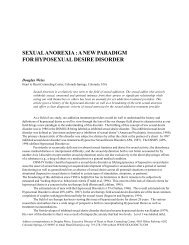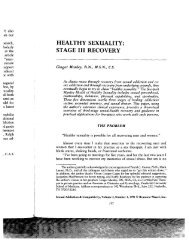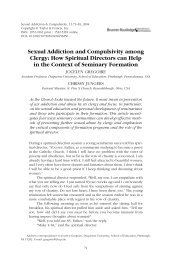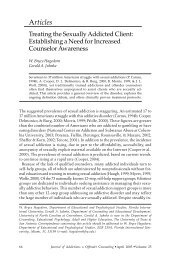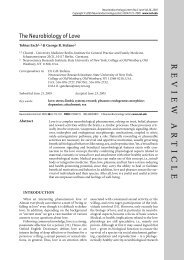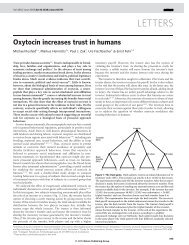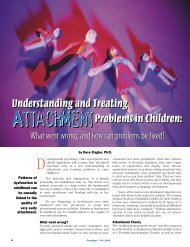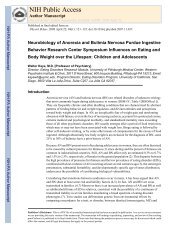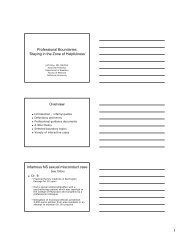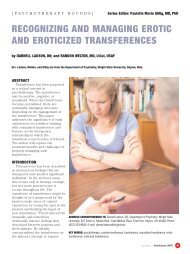An Overview of Psychiatric Ethics
An Overview of Psychiatric Ethics
An Overview of Psychiatric Ethics
You also want an ePaper? Increase the reach of your titles
YUMPU automatically turns print PDFs into web optimized ePapers that Google loves.
Psychiatry and Human Rights2“The British rarely pursued extermination, but frequently forsaw it. Officials andsettlers brought to the colonies the prevailing Lockean notions <strong>of</strong> property basedon land usage. The Aboriginies’ perceived inability to value the land and mix theirlabour with the soil purportedly put them beyond civilization” (p.252) 191Frequent instances <strong>of</strong> virtual “ethnic cleansing”, either through mass murder or attempts atassimilation <strong>of</strong> Aboriginal people with mainstream white Australia, betrayed a social Darwinistagenda, which viewed indigenous Australians as inferior beings, possessed <strong>of</strong> a primitive cultureand unworthy <strong>of</strong> the lands they had lived in for millennia. 192A more recent and troubling issue in indigenous mental health was the recognition <strong>of</strong> the pr<strong>of</strong>oundlydestructive impact the policy <strong>of</strong> forced removal <strong>of</strong> Aboriginal and Torres Strait Islander children had inthe period from 1869-1969. 193 The policy was based upon legislation in different states and involvedthe forced removal <strong>of</strong> such children from their families and their placement in the care <strong>of</strong> churchmissions or state-run facilities. Whilst the removals were argued to have been based on concernsfor children <strong>of</strong> mixed background, there is clear evidence that this was, in essence, a policy basedupon Darwinist ideology, eugenics, fears <strong>of</strong> miscegenation and a desire to maintain Caucasian racialpurity in the face <strong>of</strong> mixed race children. 194 The Northern Territory Protector <strong>of</strong> Natives, Dr. CecilCook argued the imperative that “all native characteristics <strong>of</strong> the Australian Aborigine are eradicated.The problem <strong>of</strong> our half-castes will quickly be eliminated by the complete disappearance <strong>of</strong> the blackrace, and the swift submergence <strong>of</strong> their progeny in the white” (quoted in Markus 195 p.93). Apartfrom the effect <strong>of</strong> traumatic separation on the children and their families, and the frequent instances<strong>of</strong> abuse and maltreatment in care, the truly abhorrent nature <strong>of</strong> the practice was that it representeda form <strong>of</strong> ethnic cleansing. Moreover, such notions <strong>of</strong> racial purity paralleled those in 1930sGermany, inviting the assumption <strong>of</strong> a moral equivalence between two different forms <strong>of</strong> ethniccleansing. 196 The racist motivations <strong>of</strong> this policy were not lost on the survivors. As one attestedduring the investigation which led to the Bringing Them Home report:35“We can go home to ourselves as Aboriginals, but this does not erase the attacksinflicted on our hearts, minds, bodies and souls, by caretakers who thought theirmission was to eliminate us as Aboriginals” 193The psychological consequences <strong>of</strong> this process not only included commonly recognised DSM-IVpsychiatric disorders, but an existential challenge <strong>of</strong> the “devaluation <strong>of</strong> Aboriginal parenting, statepaternalism devaluing distress <strong>of</strong> the family, forced geographic, cultural and emotional isolation,devaluation <strong>of</strong> Aboriginal culture”. 197 Whilst Australian Prime Minister Kevin Rudd referred to thissystematic violation <strong>of</strong> human rights as a “blemished chapter in our nation’s history”, the countryremained polarised along political lines as to the approach needed to the issue. <strong>An</strong> acrimoniousdebate occurred in the media between those who saw the spectre <strong>of</strong> the “stolen generation” as anational disgrace, and those who advocated polemic denials <strong>of</strong> the policy’s existence or its negativeimpact. 198 Whilst the Federal Parliament <strong>of</strong> Australia formally apologized to the “Stolen Generation”on February 13th 2008, 199 negative attitudes and state paternalism towards indigenous Australiansstill persist.The Chief Minister <strong>of</strong> the Northern Territory released the report <strong>of</strong> the Inquiry into the Protection<strong>of</strong> Aboriginal Children from Sexual Abuse on 15th June 2007 (subsequently known as the “LittleChildren are Sacred Report”). 200 On 21st June 2007 the Australian Federal Government announcedthe Northern Territory National Emergency Response Act 2007 in response to the report’s findings<strong>of</strong> widespread violence and sexual abuse <strong>of</strong> Aboriginal children in indigenous communities in theNorthern Territory. Whilst the ‘NT intervention’ was ostensibly based upon a desire to save Aboriginalchildren from their alleged plight, the process was highly political. The conservative government<strong>of</strong> the time prosecuted the intervention using the military, forced medical examinations <strong>of</strong> childrenand abolished the so-called “permit system”, which had provided Indigenous communities withautonomous control <strong>of</strong> their traditional lands. The latent racism <strong>of</strong> the intervention was evident tomany:“It is hard to find another example, recent or past, <strong>of</strong> one race being so singledout for failing to nurture its children...we were asked to accept that Aborigines,after 60,000 years <strong>of</strong> survival in some <strong>of</strong> the most hellishly harsh country knownto humans, had, in the last forty years, forgotten how to raise children”. 201IMET AN OVERVIEW OF PSYCHIATRIC ETHICS



